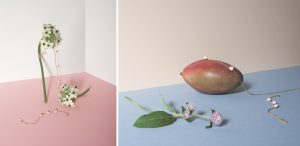Dior has launched their first jewellery collection for girls; for the first time, younger girls will be able to wear Dior necklaces and bracelets specially designed for them.
Dior is revisiting the lucky charms of Christian Dior in this jewellery collection; the lily-of-the-valley, the rose and the star act as the symbols of three collections, respectively named ‘Les Précieuses’, ‘Les Capricieuses’ and ‘Les Rêveuses.’ Gilded or silvered, these jewels make adorable gifts. These three symbols were treasured by Monsieur Dior.

Image: Dior Les Precieuses
The lily-of-the-valley was his lucky flower. Superstitious by nature, he slipped a dried sprig of the delicate flower into the hem of each of his haute-couture outfits, and was also never without one himself. He kept an ornate reliquary containing his beloved bloom in his jacket pocket.

Image: Dior Les Capricieuses
The rose was one of Christian Dior’s favourite flowers. His mother had planted a rose garden in the grounds of their villa at Granville, to which he brought his own touches, most visibly by erecting a pergola. Flowers, and roses in particular, would go on to play a very important role in his inspirations. They can be found most notably in the names of his collections or his dresses, directly inspired by the floral and plant world he so loved.

Image: Dior Les Reveuses
The star had a very special significance for Christian Dior. When he was 41 and working as a designer at Lucien Lelong, he was approached by Marcel Boussac, the most famous industrialist of the post-war period, with an offer to take over the creative direction of a fashion house named Philippe et Gaston.
Dior was hesitant. He knew that the decision would be a very important one. On the evening of April 18th, 1946, as he walked along the Rue du Faubourg-Saint-Honoré in Paris, Christian Dior’s foot struck an object that lay on the ground, attracting his attention to the pavement. He bent down and picked it up: it was a star, the one that would propel him to the haute couture and luxury firmament, his guiding star showing him the path he should follow.
His answer would be yes; he knew at that instant that he needed to take control of his destiny. But it was to be a yes with conditions. The following day, bolstered by the assurance that his star had provided, Christian Dior informed Marcel Boussac that he wouldn’t be taking over Philippe et Gaston, but was instead ready to open a house in his own name, “where everything would be new, from the mindset and the staff, to the furniture and the premises”. And that is how the house of Dior was born.
















